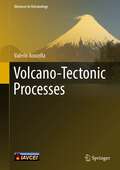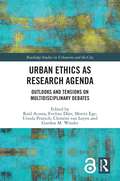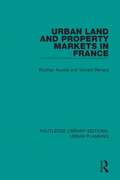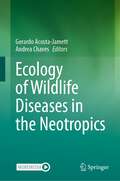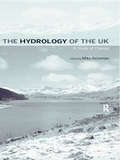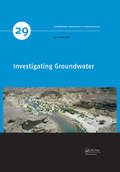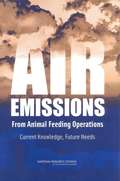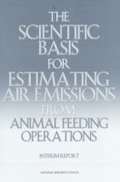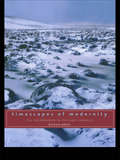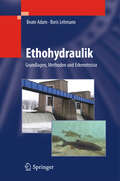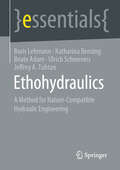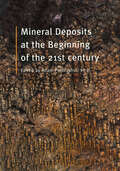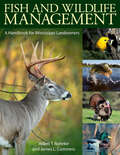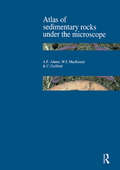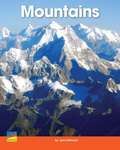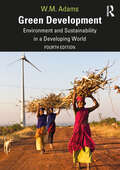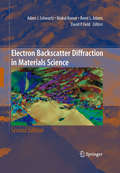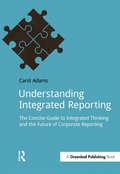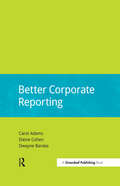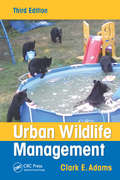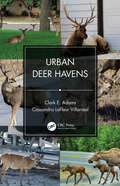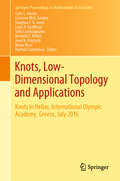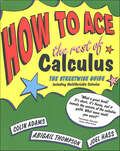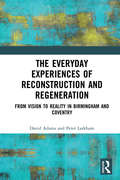- Table View
- List View
Volcano-Tectonic Processes (Advances in Volcanology)
by Valerio AcocellaVolcanoes have terrified and, at the same time, fascinated civilizations for thousands of years. Many aspects of volcanoes, most notably the eruptive processes and the compositional variations of magma, have been widely investigated for several decades and today constitute the core of any volcanology textbook. Nevertheless, in the last two decades, boosted by the availability of volcano monitoring data, there has been an increasing interest in the pre-eruptive processes related to the shallow accumulation and to the transfer of magma approaching the surface, as well as in the resulting structure of volcanoes. These are innovative and essential aspects of modern volcanology and, as driving volcanic unrest, their understanding also improves hazard assessment and eruption forecasting. So far, the significant progress made in unravelling these volcano-tectonic processes has not been supported by a comprehensive overview.This monograph aims at filling this gap, describing the pre-eruptive processes related to the structure, deformation and tectonics of volcanoes, at the local and regional scale, in any tectonic setting. The monograph is organized into three sections (“Fundamentals”, “Magma migration towards the surface” and “The regional perspective”), consisting of thirteen chapters that are lavishly illustrated. The reader is accompanied in a journey within the volcano factory, discovering the processes associated with the shallow accumulation of magma and its transfer towards the surface, how these control the structure of volcanoes and their activity and, ultimately, improve our ability to estimate hazard and forecast eruption.The potential readership includes any academic, researcher and upper undergraduate student interested in volcanology, magma intrusions, structural geology, tectonics, geodesy, as well as geology and geophysics in general.
Urban Ethics as Research Agenda: Outlooks and Tensions on Multidisciplinary Debates (Routledge Studies in Urbanism and the City)
by Raúl Acosta Eveline Dürr Moritz Ege Ursula Prutsch Clemens Van Loyen Gordon M. WinderThis book provides an outline for a multidisciplinary research agenda into urban ethics and offers insights into the various ways urban ethics can be configured. It explores practices and discourses through which individuals, collectives and institutions determine which developments and projects may be favourable for dwellers and visitors traversing cities. Urban Ethics as Research Agenda widens the lens to include other actors apart from powerful individuals or institutions, paying special attention to activists or civil society organizations that express concerns about collective life. The chapters provide fresh perspectives addressing the various scales that converge in the urban. The uniqueness of each city is, thus, enriched with global patterns of the urban. Local sociocultural characteristics coexist with global flows of ideas, goods and people. The focus on urban ethics sheds light on emerging spaces of human development and the ways in which ethical narratives are used to mobilize and contest them in terms of the good life. This timely book analyses urban ethical negotiations from social and cultural studies, particularly drawing on anthropology, geography, and history. This volume will be of interest to scholars, researchers and practitioners interested in ethics and urban studies.
Urban Land and Property Markets in France (Routledge Library Editions: Urban Planning #1)
by Rodrigo Acosta Vincent RenardOriginally published in 1994, Urban Land and Property Markets in the United Kingdom, adopts a perspective that encompasses the distinctive nature of the legal framework, land law, property market and procedures of Scotland, England and Wales. The book provides detailed accounts of the structure of property, planning and tax law governing urban land and property markets, registration procedures and transactions charges, market processes and how they all work in practice. The book is based on a report commissioned by the German Federal Government as part of a five-country study completed in 1991.
Ecology of Wildlife Diseases in the Neotropics
by Gerardo Acosta-Jamett Andrea ChavesThis contributed volume focuses on the Neotropical region, and explores the environmental, ecological and socio-economic components that facilitate the emergence of zoonotic diseases. This book highlights the primary ecological, environmental, social, and economic variables associated with the risk of maintenance, transmission, and dissemination of emerging, re-emerging, and neglected infectious diseases, in which Neotropical vertebrates are involved. It compiles up-to-date knowledge and research for the neotropical region, as well as discusses the current needs of knowledge improvement. The chapters include various examples of the cycles of infectious diseases, all with world-wide relevance where neotropical wild vertebrates are affected or involved.
The Hydrology of the UK: A Study of Change (Routledge Environmental Management)
by Mike AcremanThe Hydrology of the UK assesses the changing hydrology of the UK, focusing on key issues that affect the fundamental hydrological processes and have important implications for water resource management, flood risk and environmental quality. The bookis divided into 3 sections: Section 1 examines the causes of change to the hydrology of the UK, including the impact of climate change, land use and geomorphological change, and dam construction. Section 2 assesses the effects of these pressures on UK rivers, goundwater, lakes, ponds, reservoirs and wetlands, looking at water quality, degradation, pollution and protection. Section 3 examines the responses of goverment organisations responsible for planning and management of water, including Environment Agencies, British Hydrological Society and the growing urgency for a World Hydrology Initiative.Change will continue to be a major feature of UK hydrology in the future. This book provides an understanding of the changing hydrology of the UK and the international scene today and looks to the needs for the future.
Investigating Groundwater (IAH - International Contributions to Hydrogeology #29)
by Ian AcworthInvestigating Groundwater provides an integrated approach to the challenges associated with locating groundwater. Uniquely, the book provides a review of the wide range of techniques that can be deployed to investigate this important resource. Many of the practical examples given are based upon Australian experience but the methods have worldwide applicability. The book is published in colour and includes many original diagrams and photographs. Particular effort has been made to provide consistent terminology and SI units are used throughout the text. <P><P>Investigating Groundwater starts with an introduction to the historical significance of groundwater and gives an account of climate change. A description of the occurrence of groundwater in different rock types is then provided. A detailed account of surface water techniques is then followed by an account of the interconnections between surface water and groundwater. Four chapters describing groundwater hydraulics are then followed by four chapters describing the latest geophysical techniques. Once the best location of a borehole is determined using these techniques; chapters then describe appropriate drilling methods to use; provide a wide ranging review of geophysical logging, hydrochemical and isotopic techniques, before concluding with a detailed description of groundwater flow to a well. <P><P>Written for a worldwide audience of degree level geology/engineering practitioners, academics and students involved in groundwater resource investigation methods; Investigating Groundwater is essential reading for those involved in groundwater research. <P><P>Key Features: <li>Presents the theoretical background and a detailed description of the techniques used in the investigation of groundwater. <li>Describes the general occurrence of groundwater in different rock types; surface water hydrology and interconnected surface and groundwater systems. <li>Provides detailed descriptions of geophysical techniques (seismic, electrical, gravity and heat) and an account of available geophysical logging methods. <li>Reviews hydrochemical and isotope methods, followed by an account of drilling techniques. <li>Gives a detailed account of radial flow to a well, including appropriate modelling and pump-testing techniques and a consideration of non-linear flow. <P><P>Of interest to anyone involved in the development of groundwater resources, either for domestic supply, for agriculture or for mining.
AIR EMISSIONS From Animal Feeding Operations: Current Knowledge, Future Needs
by Ad Hoc Committee on Air Emissions from Animal Feeding Operations"Air Emissions from Animal Feeding Operation: Current Knowledge, Future Needs discusses the need for the U. S. Environmental Protection Agency to implement a new method for estimating the amount of ammonia, nitrous oxide, methane, and other pollutants emitted from livestock and poultry farms, and for determining how these emissions are dispersed in the atmosphere. The committee calls for the EPA and the U. S. Department of Agriculture to establish a joint council to coordinate and oversee short- and long-term research to estimate emissions from animal feeding operations accurately and to develop mitigation strategies. Their recommendation was for the joint council to focus its efforts first on those pollutants that pose the greatest risk to the environment and public health.
The Scientific Basis for Estimating Air Emissions from Animal Feeding Operations
by Ad Hoc Committee on Air Emissions from Animal Feeding OperationsThis is an interim report of the Ad Hoc Committee on Air Emissions from Animal Feeding Operations of the National Research Council's Committee on Animal Nutrition. The report focuses on identifying the scientific criteria needed to ensure that estimates of air emission rates are accurate, examining the basis for these criteria in the scientific literature, and assessing uncertainties associated with them. There is no subject index. Annotation (c)2003 Book News, Inc. , Portland, OR (booknews. com)
Timescapes of Modernity: The Environment and Invisible Hazards (Global Environmental Change Ser.)
by Barbara AdamTimescapes of Modernity explores the relationship between time and environmental and socio-cultural concerns. Using examples such as the BSE crisis, the Sea Empress oil pollution and the Chernobyl radiation Barbara Adam argues that environmental hazards are inescapably tied to the successes of the industrial way of life. Global markets and economic growth; large-scale production of food; the speed of transport and communication; the 24 hour society and even democratic politics are among the invisible hazards we face. With this unique 'timescape' perspective the author dislodges assumptions about environmental change, enables a rethinking of environmental problems and provides the potential for new strategies to deal with environmental hazards.
Ethohydraulik
by Beate Adam Boris LehmannUm Fließgewässer den Nutzungsansprüchen des Menschen anzupassen, sind unzählige Baumaßnahmen erforderlich. Um die Auswirkungen wasserbaulicher Aktivitäten auf die in Fließgewässern lebenden Tiere zu untersuchen, wurde die Ethohydraulik entwickelt. Sie beruht auf der Ethologie (Erforschung des Verhaltens von Tieren) und der Hydraulik (Lehre von den bewegten Flüssigkeiten). Die Autoren stellen die Grundlagen dieser Wissenschaftsdisziplin dar und liefern Regeln sowie Grenz- und Bemessungswerte für die wasserbauliche Praxis.
Ethohydraulics: A Method for Nature-Compatible Hydraulic Engineering (essentials)
by Beate Adam Boris Lehmann Ulrich Schwevers Katharina Bensing Jeffrey A. TuhtanEthohydraulics is the transdiscipline linking behavioural science (ethology) and flow behaviour (hydraulics). Ethohydraulic studies provide repeatable and scalable insights into the reactive behaviour of aquatic animals. The findings can be used to derive limits and guidelines as well as design specifications for the planning of hydraulic engineering facilities. In this essential book, the authors provide an overview of the fundamentals and methodological approaches of ethohydraulic investigations. In addition to real-world case studies, current developments and future advances are provided.This Springer essential is a translation of the original German 1ststedition essentials,Ethohydraulik by Boris Lehmann, published by Springer-Verlag GmbH Germany, part of Springer Nature in 2021. The translation was done with the help of artificial intelligence (machine translation by the service DeepL.com). A subsequent human revision was done primarily in terms of content, so that the book will read stylistically differently from a conventional translation. Springer Nature works continuously to further the development of tools for the production of books and on the related technologies to support the authors.
Mineral Deposits at the Beginning of the 21st Century
by Adam Piestrzyński et alThe Joint 6th Biennial SGA-SEG Meeting was held in Krakow in August 2001. This volume contains 274 extended abstracts, grouped thematically under 18 session titles covering topics such as lead-zinc deposits; metamorphism affecting mineral deposits; and the environmental aspects of mining.
Austral Ark
by Adam Stow Norman Maclean Gregory I. Holwell Adam Stow Norman MacleanAustralia and New Zealand are home to a remarkable and unique assemblage of flora and fauna. Sadly though, by virtue of their long isolation, and a naïve and vulnerable biota, both countries have suffered substantial losses to biodiversity since European contact. Bringing together the contributions of leading conservation biologists, Austral Ark presents the special features and historical context of Austral biota, and explains what is being conserved and why. The threatening processes occurring worldwide are discussed, along with the unique conservation problems faced at regional level. At the same time, the book highlights many examples of conservation success resulting from the innovative solutions that have been developed to safeguard native species and habitats in both New Zealand and Australia. Austral Ark fills an important gap regarding wildlife gains and declines, and how best to take conservation forward to keep this extraordinary area of the world thriving.
Fish and Wildlife Management: A Handbook for Mississippi Landowners
by Adam T. Rohnke and James L. CumminsFeaturing over five hundred illustrations and forty tables, this book is a collection of in-depth discussions by a tremendous range of experts on topics related to wildlife and fisheries management in Mississippi. Beginning with foundational chapters on natural resource history and conservation planning, the authors discuss the delicate balance between profit and land stewardship. A series of chapters about the various habitat types and the associated fish and wildlife populations that dominate them follow. Several chapters expand on the natural history and specific management techniques of popular species of wildlife, including white-tailed deer, eastern wild turkey, and other species. Experts discuss such special management topics as supplemental, wildlife-food planting, farm pond management, backyard habitat, nuisance animal control, and invasive plant species control. Leading professionals who work every day in Mississippi with landowners on wildlife and fisheries management created this indispensable book. The up-to-date and applicable management techniques discussed here can be employed by private landowners throughout the state. For those who do not own rural lands but have an interest in wildlife and natural resources, this book also has much to offer. Residents of urban communities interested in creating a wildlife-friendly yard will delight in the backyard habitat chapter specifically written for them. Whether responsible for one-fourth of an acre or two thousand, landowners will find this handbook to be an incalculable aid on their journey to good stewardship of their Mississippi lands.
Atlas of Sedimentary Rocks Under the Microscope
by A. E. Adams W. S. Mackenzie C. GuilfordProvides a very clear guide to sedimentary rock types as seen under the microscope supported by practical aspects of slide preparation.
Green Development: Environment and Sustainability in a Developing World
by Bill AdamsThe concept of sustainability lies at the core of the challenge of environment and development, and the way governments, business and environmental groups respond to it. Green Development provides a clear and coherent analysis of sustainable development in both theory and practice. Green Development explores the origins and evolution of mainstream thinking about sustainable development and offers a critique of the ideas behind them. It draws a link between theory and practice by discussing the nature of the environmental degradation and the impacts of development. It argues that, ultimately, ‘green’ development has to be about political economy, about the distribution of power, and not about environmental quality. Its focus is strongly on the developing world. The fourth edition retains the broad structure of previous editions, but has been updated to reflect advances in ideas and changes in international policy. Greater attention has been given to the political ecology of development, and market-based and neoliberal environmentalism, and degrowth. This fully revised edition discusses: the origins of thinking about sustainability and sustainable development, and its evolution to the present day. the ideas that dominate mainstream sustainable development (including natural capital, the green economy, market environmentalism and ecological modernization). critiques of mainstream ideas and of neoliberal framings of sustainability, and alternative ideas about sustainability that challenge ‘business as usual’ thinking, such as arguments about limits to growth, and calls for degrowth. the dilemmas of sustainability in the context forests, desertification, food and faming, biodiversity conservation and dam construction. the challenge of policy choices about sustainability, particularly between reformist and radical responses to the contemporary global dilemmas. Green Development offers clear insights into the challenges of environmental sustain- ability, and social and economic development. It is unique in offering a synthesis of theoretical ideas on sustainability and in its coverage of the extensive literature on environment and development around the world. The book has proved its value to generations of students as an authoritative, thought-provoking and readable guide to the field of sustainable development.
Electron Backscatter Diffraction in Materials Science
by Brent L. Adams Mukul Kumar Adam J. Schwartz David P. FieldElectron backscatter diffraction is a very powerful and relatively new materials characterization technique aimed at the determination of crystallographic texture, grain boundary character distributions, lattice strain, phase identification, and much more. The purpose of this book is to provide the fundamental basis for electron backscatter diffraction in materials science, the current state of both hardware and software, and illustrative examples of the applications of electron backscatter diffraction to a wide-range of materials including undeformed and deformed metals and alloys, ceramics, and superconductors. The text has been substantially revised from the first edition, and the authors have kept the format as close as possible to the first edition text. The new developments covered in this book include a more comphrensive coverage of the fundamentals not covered in the first edition or other books in the field, the advances in hardware and software since the first edition was published, and current examples of application of electron backscatter diffraction to solve challenging problems in materials science and condensed-matter physics.
Understanding Integrated Reporting: The Concise Guide to Integrated Thinking and the Future of Corporate Reporting
by Carol AdamsIntegrated Reporting is the big new development in corporate reporting that everyone is talking about. Why? Quite simply, Integrated Reporting marks a paradigm shift in the way companies and other organizations think about business models and the creation of value. Integrated Reporting promotes long term thinking about value-creation and stewardship across a broad base of interdependent capitals – financial, manufactured, human, intellectual, natural, and social and relationship.With updated references and case studies to take account of the latest developments in Integrated Reporting, this book provides a practical and expert distillation of for IR professionals.Internationally renowned sustainability reporting expert and accountant Dr Carol Adams explains in simple terms what is and how to do it; how it links with other reporting frameworks and what it means in terms of thinking and processes. You'll also get a clear business case for IR and insights and best practice examples from leading integrated reporters. Integrated Reporting is not just for companies.This book demonstrates how integrated thinking and IR can benefit many other organizations whose success and influence depends on relationships and partnerships.
Better Corporate Reporting (Doshorts Ser.)
by Carol Adams Elaine Cohen Dwayne BarakaBetter Corporate Reporting outlines the latest frameworks for enhancing non-financial and sustainability reporting. It shows you how to integrate non-financial data into your reporting and overall strategy, creating long-term value, trust and transparency. It includes guides to: the International Integrated Reporting Council's new framework; the Global Reporting Initiative's G4 framework; and a detailed look at the concept at the heart of both of these new frameworks, materiality. It is the compilation of 3 bestselling sustainability guides on sustainability reporting.Understanding Integrated Reporting provides a practical and expert distillation of the new IR framework released by the International Integrated Reporting Council in December 2013. It explains what IR is and how to do it; how it links with other reporting frameworks and what it means in terms of thinking and processes. You'll also get a clear business case for IR and insights and best practice examples from leading integrated reporters. The Global Reporting Initiative (GRI) G4 Sustainability Reporting Framework was launched in May 2013. In Understanding G4, corporate reporting veteran Elaine Cohen presents an easy-to-follow review of everything any organization needs to know to decide whether to use the G4 Framework and if so, how. Materiality is the lynch-pin that can align your sustainability initiatives with your overall strategy. Making Sustainability Matter shows you how to identify your organization's most material sustainability issues, allocate resources to sustainability initiatives for optimal returns; connect your communications and reporting to materiality, and; clarify which issues are important to your stakeholders. Materiality is a core concept in both the GRI's new G4 framework the IIRC's new Integrated Reporting framework.
Urban Wildlife Management
by Clark E. AdamsWinner of the 2018 TWS Wildlife Publication Awards in the authored book category Urban development is one of the leading worldwide threats to conserving biodiversity. In the near future, wildlife management in urban landscapes will be a prominent issue for wildlife professionals. This new edition of Urban Wildlife Management continues the work of its predecessors by providing a comprehensive examination of the issues that increase the need for urban wildlife management, exploring the changing dynamics of the field while giving historical perspectives and looking at current trends and future directions. The book examines a range of topics on human interactions with wildlife in urbanized environments. It focuses not only on ecological matters but also on political, economic, and societal issues that must be addressed for successful management planning. This edition features an entirely new section on urban wildlife species, including chapters on urban communities, herpetofauna, birds, ungulates, mammals, carnivores, and feral and introduced species. The third edition features Five new chapters 12 updated chapters Four new case studies Seven new appendices and species profiles 90 new figures A comprehensive analysis of terrestrial vertebrate locations by state and urban observations Each chapter opens with a set of key concepts which are then examined in the following discussions. Suggested learning experiences to enhance knowledge conclude each chapter. The species profiles cover not only data about the animal concerned but also detail significant current management issues related to the species. An updated and expanded teaching tool, Urban Wildlife Management, Third Edition identifies the challenges and opportunities facing wildlife in urban communities as well as factors that promote or threaten their presence. It gives both students and professionals a solid grounding in the required fundamental ecological principles for understanding the effects of human-made environments on wildlife.
Urban Deer Havens
by Clark E. Adams Cassandra LaFleur VillarrealUrban Deer Havens consists of a thorough examination of selected cervid (deer) species that are known to inhabit urban communities in the United States. The deer species that are included in this presentation consisted of white-tailed (Odocoileus virginianus), Key deer (O. v. clavium), moose (Alces alces), elk (Cervus elaphus), mule (Odocoileus hemionus), and black-tailed deer (O. h. columbianus). This book is the first attempt to examine the similarities and differences in those factors that allow the selected cervids to exist and thrive in urban habitats. This information has never been collected, collated, reviewed, and published under one cover document. Yet, all five are known to inhabit urban communities within their geographic range. The lack of information concerning several important examples of urban cervids in conjunction with a proliferation of information on white-tailed deer only is an incomplete and biased presentation. This book is the first comprehensive source of information on urban deer management, which includes a broad assemblage of urban cervids. The overall objective of this book is to provide a more holistic examination of urban cervids. For example, it examines the similarities and differences of the environmental impacts, management strategies, and human dimensions considerations concerning urban cervids in general, and using specific examples. Urban Deer Havens features four chapters that include: Urban deer census techniques and population dynamics Comprehensive tables that review urban community deer management plans National and state-wide estimates the five selected cervids Laws and regulations concerning urban deer Lethal and nonlethal management options for managing deer Steps for managing urban deer populations Examples of urban deer management efforts
Knots, Low-Dimensional Topology and Applications: Knots in Hellas, International Olympic Academy, Greece, July 2016 (Springer Proceedings in Mathematics & Statistics #284)
by Colin C. Adams Cameron McA. Gordon Vaughan F. R. Jones Louis H. Kauffman Sofia Lambropoulou Kenneth C. Millett Jozef H. Przytycki Renzo Ricca Radmila SazdanovicThis proceedings volume presents a diverse collection of high-quality, state-of-the-art research and survey articles written by top experts in low-dimensional topology and its applications. The focal topics include the wide range of historical and contemporary invariants of knots and links and related topics such as three- and four-dimensional manifolds, braids, virtual knot theory, quantum invariants, braids, skein modules and knot algebras, link homology, quandles and their homology; hyperbolic knots and geometric structures of three-dimensional manifolds; the mechanism of topological surgery in physical processes, knots in Nature in the sense of physical knots with applications to polymers, DNA enzyme mechanisms, and protein structure and function. The contents is based on contributions presented at the International Conference on Knots, Low-Dimensional Topology and Applications – Knots in Hellas 2016, which was held at the International Olympic Academy in Greece in July 2016. The goal of the international conference was to promote the exchange of methods and ideas across disciplines and generations, from graduate students to senior researchers, and to explore fundamental research problems in the broad fields of knot theory and low-dimensional topology. This book will benefit all researchers who wish to take their research in new directions, to learn about new tools and methods, and to discover relevant and recent literature for future study.
How to Ace the Rest of Calculus: The Streetwise Guide (How to Ace)
by Colin Adams Abigail Thompson Joel HassThe sequel to How to Ace Calculus, How to Ace the Rest of Calculus provides humorous and highly readable explanations of the key topics of second and third semester calculus-such as sequences and series, polor coordinates, and multivariable calculus-without the technical details and fine print that would be found in a formal text.
The Everyday Experiences of Reconstruction and Regeneration: From Vision to Reality in Birmingham and Coventry
by David Adams Peter LarkhamSet within a wider British and international context of post-war reconstruction, The Everyday Experiences of Reconstruction and Regeneration focuses on such debates and experiences in Birmingham and Coventry as they recovered from Second World War bombings and post-war industrial collapse. Including numerous images, Adams and Larkham explore the initial development of the post-Second World War reconstruction projects, which so substantially changed the face of the cities and provided radical new identities. Exploring these cities throughout the post-war period brings into sharp focus the duality of contemporary approaches to regeneration, which often criticise mid-twentieth century ’poorly-conceived’ planning and architectural projects for producing inhuman and unsympathetic schemes, while proposing exactly the type of large-scale regeneration that may potentially create similar issues in the future. This book would be beneficial for academics and students of planning and urban design, particularly those with an interest in post-catastrophe or large-scale reconstruction projects within cities.
